

Peter Blake: new collages. Peter Blake. Kenny Scharf Catalogue. "The very moment Kenny Scharf was introduced to me by Keith Haring around 1988, I knew he was going to be great fun and a central part of my life.

Keith, as well as all of the artists of the New York art scene who knew Kenny at the time, thought he was the coolest, the funniest and the hippest artist ever to come along. A true child of the television age, he already possessed a fantastic lust for life and adventure, and his art celebrates that. What the Surrealist painters in Europe, in particular Dali, Tanguy and Ernst introduced to modern culture, Kenny has taken to a new level by infusing it with the genius and animated comedy of Hanna Barbera (The Jetsons and The Flintstones) and Walt Disney (Fantasia). Kenny Scharf has brought back to art the wonder of perpetual imagination with zing and boundless humor.
His art is electrically charged with the "grooviest" and "zaniest" innovations at the frontier of creative and playful discovery. Claude Cahun. Claude Cahun: Finding a lost great. A writer born into literary royalty, with a pseudonym to hide the fact; a forebear of Cindy Sherman, with only one self-portrait published in her lifetime; a lesbian in love with her step-sister; a Jewish, Marxist Surrealist – Claude Cahun is probably the most complicated artist you and I have never heard of.
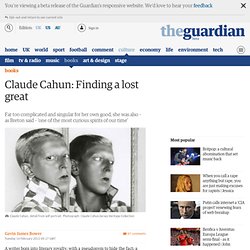
Born 1894, real name Lucy Schwob – her uncle was the great Symbolist writer Marcel Schwob – Cahun was educated at the Sorbonne, moved to Montparnasse in 1922 and spent the subsequent 16 years in the French capital. Pre-Paris, she fell for Suzanne Malherbe, the daughter of her stepmother, and the couple collaborated – to varying extents – on Cahun's literary and visual output over five decades. With fascism on their doorstep, in 1938 they moved to Jersey – only for the island to become the one part of the British Isles to suffer Nazi occupation. Claude Cahun: Androgyne, Surrealist, Activist. Kara Walker - What's On - Camden Arts Centre. American artist Kara Walker (b. 1969) fills all three gallery spaces at Camden Arts Centre over the autumn months.

Renouncing the sensitivity that often shrouds the subject, Walker’s work critically and unapologetically interrogates underlying racial and gender tensions. Through characters drawn from American popular literature, culture and history, she exposes the myths that lie beneath cultural archetypes and the darker aspects of human behaviour. Walker’s new work reflects her current research into the White Supremacist movement and gun culture in the US. Peopled with subjects from both past and contemporary history, the work weaves together historical documents of slavery with more recent racial issues. The exhibition brings together several important bodies of recent work. Kara Walker. Art and design. Marcel Janco. Marcel Janco Marcel Janco’s life history can be divided into two main chapters: 46 years in Europe and .

Henri Matisse (1869–1954) David Hockney. English painter, printmaker, photographer and stage designer.
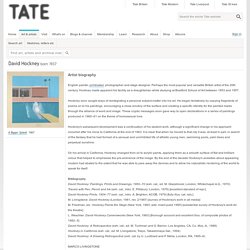
Perhaps the most popular and versatile British artist of the 20th century, Hockney made apparent his facility as a draughtsman while studying at Bradford School of Art between 1953 and 1957. Hockney soon sought ways of reintegrating a personal subject-matter into his art. He began tentatively by copying fragments of poems on to his paintings, encouraging a close scrutiny of the surface and creating a specific identity for the painted marks through the alliance of word and image.
These cryptic messages soon gave way to open declarations in a series of paintings produced in 1960–61 on the theme of homosexual love. Reginald Case. Tom Wesselmann. Still Life #30. April 1963. Still Life #30 is a large still-life of a table laden with images of fresh and packaged food, balanced by a pink refrigerator door, 7-Up bottles, and a window with a view to the city.
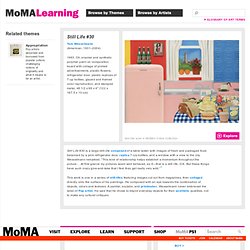
Wesselmann remarked, “This kind of relationship helps establish a momentum throughout the picture… At first glance my pictures seem well behaved, as if—that is a still life, O.K. But these things have such crazy give-and-take that I feel they get really very wild.” This work is one in a series of featuring images cut out from magazines, then directly onto the surface of his paintings. Tom Wesselmann (American, 1931–2004) Tom Wesselmann. Raoul Hausmann. DADA Companion.
Raoul Hausmann Raoul Hausmann was born in Vienna (1886).
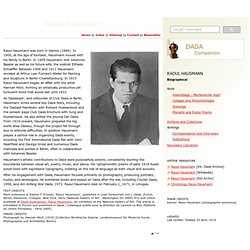
In 1900, at the age of fourteen, Hausmann moved with his family to Berlin. In 1905 Hausmann met Johannes Baader as well as his future wife, the violinist Elfriede Schaeffer. Between 1908 and 1911 Hausmann enrolled at Arthur Lew-Funcke's Atelier for Painting and Sculpture in Berlin-Charlottenburg. In 1915 Raoul Hausmann began an affair with the artist Hannah Höch, forming an artistically productive yet turbulent bond that would last until 1922. Richard Hamilton. Richard Hamilton. Hamilton was born in London.
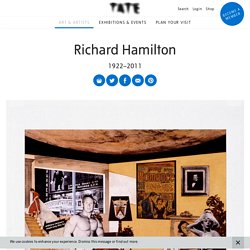
He was educated at the Royal Academy Schools from 1938 to 1940, then studied engineering draughtsmanship at a Government Training Centre in 1940, then worked as a 'jig and tool' designer. He returned in 1946 to the Royal Academy Schools, from which he was expelled for 'not profiting from the instruction being given in the painting school' (Hamilton, p.10), then attended the Slade School of Art from 1948 to 1951.
An exhibition of his engravings was held at Gimpel Fils, London, in 1950. These were inspired by D'Arcy Wentworth Thompson's 1913 text On Growth and Form which had been republished in 1942 and was a seminal influence on Hamilton's early work. Man Ray Portraits − Past − What's On. Man Ray. Man Ray 1890-1976.

Kurt Schwitters collages – in pictures. Kurt Schwitters (German, 1887–1948) Kurt Schwitters. Art and design. Paul Klee (1879–1940) Miraculous Landing, or the "112!
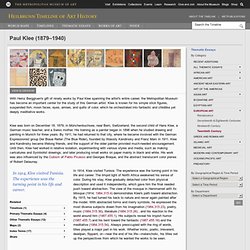
", 1920 Paul Klee (German, 1879–1940) Watercolor, transferred printing ink, pen, and ink on paper; 9 3/8 x 12 1/2 in. (23.6 x 31.8 cm) The Berggruen Klee Collection, 1984 (1984.315.23) © 2011 Artists Rights Society (ARS), New York / VG Bild-Kunst, Bonn With Heinz Berggruen's gift of ninety works by Paul Klee spanning the artist's entire career, the Metropolitan Museum has become an important center for the study of this German artist. Paul Klee. Georges Braque (French, 1882–1963) Georges Braque. Georges Braque. B. 1882, Argenteuil-sur-Seine, France; d. 1963, Paris Georges Braque was born on May 13, 1882, in Argenteuil-sur-Seine, France.
He grew up in Le Havre and studied evenings at the École des Beaux-Arts there from about 1897 to 1899. He left for Paris to study under a master decorator to receive his craftsman certificate in 1901. From 1902 to 1904 he painted at the Académie Humbert in Paris, where he met Marie Laurencin and Francis Picabia. By 1906 Braque’s work was no longer Impressionist but Fauve in style; after spending that summer in Antwerp with Othon Friesz, he showed his Fauve work the following year in the Salon des Indépendants in Paris.
After World War I Braque’s work became freer and less schematic. During World War II Braque remained in Paris.